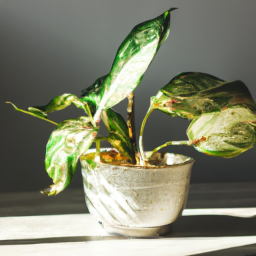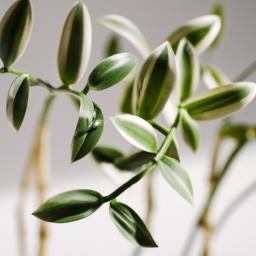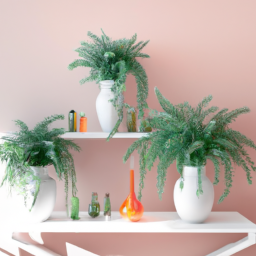
Are indoor plants safe? This is a common question that many people have when considering adding greenery to their indoor spaces. While indoor plants can bring beauty and a sense of tranquility to your home or office, there are some potential risks to be aware of. In this blog post, we will explore the safety of indoor plants, including the benefits they offer and any precautions you should take to ensure a healthy environment for both you and your plants. So, let’s dive in and learn more about the safety of indoor plants!
Potential Health Benefits of Indoor Plants
Indoor plants are not only a beautiful addition to any home or office space, but they also offer a range of potential health benefits. From improving air quality to reducing stress levels, indoor plants can have a positive impact on our overall well-being.
Improving Air Quality
One of the most well-known benefits of indoor plants is their ability to improve air quality. Plants absorb carbon dioxide and release oxygen through the process of photosynthesis, helping to purify the air we breathe. Some plants, such as spider plants and peace lilies, are particularly effective at removing toxins like formaldehyde and benzene from the air.
In addition to producing oxygen and removing toxins, indoor plants can also increase humidity levels in a room. This can be especially beneficial during the winter months when indoor heating systems can dry out the air, leading to respiratory issues and dry skin.
By incorporating a variety of indoor plants into your living or working space, you can create a healthier environment for yourself and your loved ones. Just be sure to choose plants that are safe for pets if you have furry friends at home.
Reducing Stress and Anxiety
Research has shown that spending time around indoor plants can help reduce stress and anxiety levels. The presence of greenery has a calming effect on the mind, promoting relaxation and a sense of well-being. In fact, simply looking at a plant can have a positive impact on our mood and mental health.
In addition to their visual appeal, indoor plants can also improve acoustics in a room by absorbing sound and reducing noise levels. This can create a more peaceful and serene environment, perfect for unwinding after a long day or focusing on work or study.
Whether you choose to place a few small plants on your desk or create a lush indoor garden in your living room, incorporating greenery into your space can help promote a sense of tranquility and balance in your life.
Promoting Physical Health
Indoor plants can also have a positive impact on our physical health. Studies have shown that patients in hospital rooms with plants tend to experience faster recovery times and require less pain medication than those in rooms without greenery. The presence of plants can help lower blood pressure, reduce fatigue, and boost overall well-being.
In addition to their healing properties, indoor plants can also improve cognitive function and productivity. Research has shown that having plants in the workplace can enhance concentration, memory, and creativity, making us more efficient and effective in our tasks.
By incorporating indoor plants into our living and working spaces, we can reap a multitude of health benefits that contribute to a happier and healthier lifestyle. So go ahead and bring some greenery into your life – your mind, body, and soul will thank you!

Are Indoor Plants Safe?
Introduction
Indoor plants are a great way to bring nature into your home and improve air quality. However, many pet owners are concerned about whether indoor plants are safe for their furry friends. In this article, we will explore the safety of indoor plants and provide a guide on how to choose plants that are safe for pets.
Potential Risks of Indoor Plants
While indoor plants can provide numerous benefits, such as improving air quality and reducing stress, there are some potential risks to be aware of. Some indoor plants can be toxic to pets if ingested, causing symptoms ranging from mild gastrointestinal upset to more severe reactions.
It’s important to research the toxicity of indoor plants before bringing them into your home, especially if you have pets. Common toxic plants include lilies, philodendrons, and aloe vera. Symptoms of plant toxicity in pets can include vomiting, diarrhea, lethargy, and in severe cases, organ failure.
To minimize the risk of plant toxicity to pets, it’s essential to choose plants that are safe for pets and place them out of reach. If you suspect that your pet has ingested a toxic plant, contact your veterinarian immediately.
Choosing Safe Indoor Plants for Pets
When selecting indoor plants for your home, it’s essential to choose plants that are safe for pets. Some indoor plants are non-toxic to pets and can be a safe addition to your home. Here are some common indoor plants that are safe for pets:
Spider Plant: Spider plants are safe for pets and can help improve air quality in your home. They are easy to care for and can thrive in a variety of lighting conditions.
Boston Fern: Boston ferns are non-toxic to pets and can add a touch of greenery to your home. They prefer high humidity and indirect sunlight, making them ideal for bathrooms or kitchens.
Areca Palm: Areca palms are safe for pets and can help purify the air in your home. They require bright, indirect light and regular watering to thrive.
When choosing indoor plants for your home, be sure to research the toxicity of the plant and consider your pet’s behavior. Keep toxic plants out of reach and monitor your pet’s interactions with plants to ensure their safety.
In conclusion, indoor plants can be a safe and beneficial addition to your home if you choose plants that are safe for pets. By researching plant toxicity and selecting non-toxic plants, you can create a pet-friendly indoor garden that enhances your living space. Remember to always monitor your pet’s interactions with plants and seek veterinary care if you suspect plant toxicity.

Tips for Ensuring Indoor Plants are Safe for Children
Understanding the Risks
Indoor plants can bring a touch of nature into your home, but it’s important to be aware of the potential risks they can pose to children. Some plants may be toxic if ingested, while others may have sharp thorns or spines that can cause injury. It’s crucial to research the plants you have in your home and understand any potential hazards they may present.
When choosing indoor plants for your home, consider the age and behavior of your children. Young children are more likely to explore their environment by touching and tasting things, so it’s important to select plants that are safe for them to be around. Keep in mind that some plants may be safe for adults but not for children, so always err on the side of caution.
Safe Plant Options
There are plenty of indoor plant options that are safe for children to be around. Some popular choices include spider plants, Boston ferns, and African violets. These plants are non-toxic and pose minimal risk to children. It’s always a good idea to research any plant before bringing it into your home, especially if you have young children.
In addition to choosing safe plants, it’s important to place them out of reach of children. Consider hanging plants from the ceiling or placing them on high shelves to prevent curious little hands from getting into trouble. You can also create designated “no-touch zones” for plants that may pose a higher risk to children.
Teaching Children About Plant Safety
One of the best ways to ensure indoor plants are safe for children is to educate them about plant safety. Teach your children which plants are safe to touch and which are off-limits. Encourage them to ask questions if they’re unsure about a plant, and explain why some plants may be dangerous.
It’s also a good idea to teach children about the importance of washing their hands after touching plants, especially if they have been handling soil or plant parts. This can help prevent accidental ingestion of potentially harmful substances. By involving children in plant care and safety, you can help them develop a healthy respect for nature and its potential hazards.
Overall, with proper research, careful plant selection, and education, you can create a safe environment for children to enjoy indoor plants. By following these tips, you can ensure that your home is a green and healthy space for the whole family to enjoy.
Essential Points
Many people love having indoor plants in their homes for their aesthetic appeal and air-purifying benefits. However, there are concerns about whether indoor plants are safe, especially for households with pets or small children. While most indoor plants are safe to have around, some can be toxic if ingested.
It’s important to do your research and choose non-toxic plants if you have pets or young children in your home. Some common indoor plants that are safe to have around include spider plants, Boston ferns, and African violets. Remember to keep toxic plants out of reach of pets and children, and be cautious when bringing new plants into your home. Overall, indoor plants can be a great addition to your space as long as you choose wisely and take proper precautions.
Here are the top questions that we were asked:
Q1: Are indoor plants safe to have around pets?
A1: Yes, most indoor plants are safe for pets, but some can be toxic if ingested. It’s important to research each plant before bringing it into your home if you have pets.
Q2: Can indoor plants improve air quality?
A2: Yes, indoor plants can help improve air quality by removing toxins and releasing oxygen. Some plants are better at this than others, so it’s a good idea to choose plants known for their air-purifying abilities.
Q3: Do indoor plants require a lot of maintenance?
A3: It depends on the plant. Some indoor plants require more maintenance than others, but there are plenty of low-maintenance options available for those who don’t have a green thumb.
Q4: Can indoor plants help reduce stress and improve mood?
A4: Yes, studies have shown that indoor plants can help reduce stress and improve mood. Being around plants can have a calming effect and help create a more positive environment.
Q5: Are there any health benefits to having indoor plants?
A5: Yes, indoor plants have been shown to have several health benefits, including improving concentration, boosting creativity, and reducing symptoms of anxiety and depression. They can also help lower blood pressure and reduce the risk of illnesses.
Dr. Olivia Green is a botanist with over two decades of experience in indoor plant cultivation. She holds a Ph.D. in Plant Biology and has dedicated her career to researching plant behavior in controlled environments. Dr. Green is passionate about helping plant enthusiasts master the art of indoor gardening through her extensive knowledge and practical insights.


